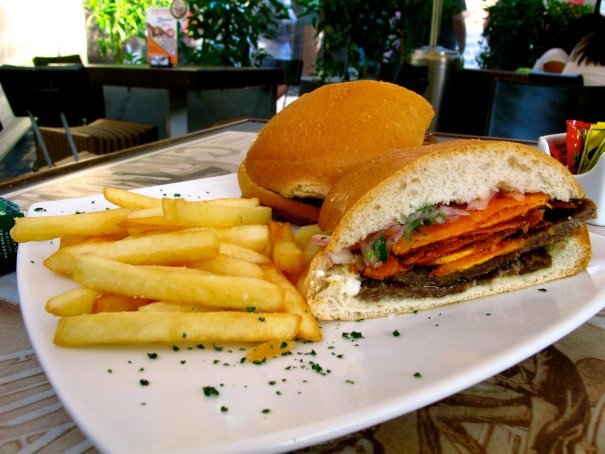
Eating Peru in One Sandwich

Eating Peru in One Sandwich
Sánguche Criollo in Peru
My time in Peru was marked by a heady blend of the mundane and the magnificent: the former, the daily grind and banal cubicles of my month-long internship, the latter, the thrill of the exotic surroundings and my first time on the continent. In my off hours I sat wrapped in the low slung hammock of my hostel’s courtyard and the balmy heat of a January summer.
In emails and Skype calls home, I fielded breathless inquiries from well-meaning but frustrating friends. “Have you visited Cusco, Machu Picchu?” “Seen the Nazca lines?” “What about the desert? I’ve heard you can sandboard there.” The truth is, in thirty days I never once stepped foot outside a capital city most tourists have historically treated as a two-days-at-most stopover. My job was demanding, and the infrastructure less conducive to the easy weekend jaunts I took for granted during my study abroad in Europe.
But I came to appreciate this, despite my wanderlust, for the silver lining to my confinement was the extent to which I was able to discover the city, and uncover within its streets, people, and cuisine microcosmic shades of Peru’s kaleidoscopic diversity.
Across three distinct topographical regions (the coast, the highlands, and the rainforest), Peru counts among its citizens Aymara and Quechua speaking Amerindians; descendants of different waves of German, Italian, Croatian, and French immigrants; Afro-Peruvians whose ancestors arrived via the colonial slave trade; children who grew up conversing as easily in Spanish as their parents’ Japanese or Chinese; and every combination in between. From this inebriating brew has emerged one of the world’s finest gastronomies, enough to change the equation and now drive tourists to Lima simply to eat.
On weekend mornings I would walk the broad boulevards of posh Miraflores, passing internationally renowned restaurants in search of more simple fare. On a given day, it could be ceviche, fresh from the Pacific, or chifa, Peru’s popular homegrown remix of Chinese food. But a favorite was always a sánguche criollo, or “creole sandwich,” consumed at Larcomar, Lima’s famous open-air shopping mall.
Built directly into the cliffs that mark Lima’s urban coastline, it was as bizarre as it was beautiful to dine there while watching a procession of paragliders soar closely overhead. But though I should have been looking up, I was more interested in looking down at the colors on my plate: the burnt orange of the yams, the greens and pinks of the bright salsa criolla, and the earthy rust of the pounded steak held gently between a light roll. A variant of the butifarra sandwich (a Peruvian staple), my sánguche would always arrive with the requisite set of yellow, orange, and green ají sauces, spicy condiments made varyingly of coriander, tomato, local peppers, and onion.
There, between bites of a sandwich in a city I never left, my restlessness dissipated, and I felt the totality of Peru represented in the diverse and nuanced flavors of the dish. In that instant I felt transported to each and every unvisited part of the country, from the foggy peaks of Machu Picchu to the sandy edges of the Atacama.